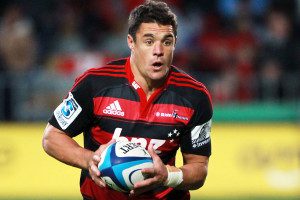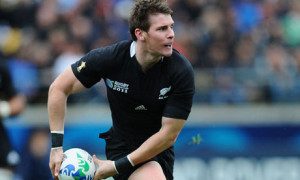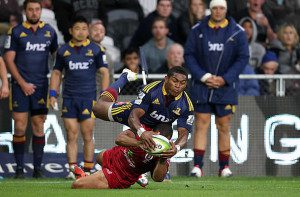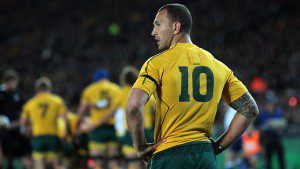

CASTRES, FRANCE – Once upon a time, European rugby was regarded as a well-earned big-money pension plan for All Blacks whose international careers were all-but behind them.
No more. Now younger players want a slice of the northern hemisphere’s big-money action, too and they appear to be saying that if it means giving up on the All Blacks in favour of bigger paydays… so be it.
It’s a side-effect of professionalism that fans hate. Loyalty – that age-old currency of sport in general and rugby in particular – has been tested to destruction by the lure of contracts that promise to feature lots of curvy zeroes in all the right places.
Players have value – and they know it. They want a slice of some big-money action. They see it as appropriate reward for all the hours they put in.
Fans know that rugby is a tough game and careers can be brutally short. What they sometimes forget is that players cannot live on loyalty and adulation alone. They have to earn money where, when and how they can. And money – especially European money – talks. It’s tempting New Zealanders, South Africans and Australians to sing, dance and walk their way north – deaf to the cries of dismay following them.

France’s Top 14, England’s Premiership and the Celtic-Italian Pro 12 have long offered a highly profitable retirement plan for southern hemisphere rugby legends and cast-offs prepared to be written off by fans and New Zealand media as having o’ervaulting ambitions beyond their talents.
After the World Cup, New Zealand heroes Dan Carter and Ma’a Nonu will stay behind on the top half of the world with the good wishes and “good luck to thems” of many a New Zealand rugby fan as the sun finally goes down on two seriously fine careers.
Fair enough. Neither is likely to have enough left in the tank to make Japan 2019.
They will follow in the cleats of many a talented ex-All Black; Ali Williams, Carl Hayman, Sitiveni Sivivatu and Joe Rokocoko are among those using nice paychecks to lap up la vie Français, while across the English Channel, Leicester Tigers’ Brad Thorn will finally call time on his professional career at the grand old age of 40, at the end of the Aviva Premiership season.
New Zealand has not been the only target for European clubs. Australian Matt Giteau was tempted to France after being cast into the international cold in 2011. The Toulon star is now among the highest earners in the Top 14. For a while it was he – not Dan Carter – who was touted as the player most likely to break the €1million-a-year bracket, when Racing Metro hinted at an interest in his signature.
Fellow former Wallaby Rocky Elsom is now a key shareholder of French second-tier side Narbonne, which basks in 300 days of Mediterranean sun every year, where he’s in charge of a club that features ex-All Black Jerry Collins.
Another Australian, Brock James, did not even wait to wear the Wallabies’ senior shirt before he swapped Western Force blue for Clermont yellow in 2006.
South Africans Bakkies Botha and Bryan Habana are also feathering their post-playing career nests with lucrative career-twilight contracts at Toulon, while Morne Steyn is reportedly earning close to €250,000 a year to warm the bench at Stade Francais.

But the lure of this kind of money, this kind of lifestyle is spreading beyond the soon-to-retire, the hasbeens and the not-quite-weres. Rich European clubs are increasingly tempting younger players from New Zealand, Australia and South Africa – and no longer just those who have decided – rightly or wrongly – that future international ambitions may be unrealistic.
Last week Crusaders’ Colin Slade had put pen to paper on a three-year deal with Pau that is reportedly worth €500,000 annually. The news finally brought the curtain down on a convoluted will-he-won’t-he saga of apparently spiraling wage demands and reported interest from other clubs, notably Toulon.
The 27-year old later admitted that the amount of money on offer made it close-to impossible to turn down – even though it was claimed he had been holding out for an extra €150,000 a year.
“You weigh up if these opportunities come up again in the future and ultimately I wasn’t prepared to take that risk,” Slade told TVNZ. “The money was the thing that initially caught my attention.”
Meanwhile, Crusaders’ “other” fly-half Tom Taylor is set to swap Christchurch for Bayonne next season – prompting something of a fly-half crisis at the club.
Charles Piutau and Francis Saili will play club rugby in Ireland next season, for Ulster and Munster respectively, while Jeremy Thrush is heading to Aviva Premiership side Gloucester. Ben Franks will sport a London Irish shirt next season, and Frank Halai is set to join Wasps. Whether they actually make the World Cup squad is open to debate, but all would surely have been on coach Steve Hansen’s long-list.

Another rising New Zealand star, Highlanders winger Waisake Naholo, also last week signed with Clermont.
Halai, at 29, is the oldest member of the New Zealand exodus and it’s a pretty safe bet there will be further Euro raids on the New Zealand-Australian-South African talent bank.
Quade Cooper was in the crowd at Marseille as Toulon beat Leinster in the European Champions Cup semi-final on Sunday as he weighed-up his post-World Cup options. On Tuesday, it was reported in the French media that he had signed a two-year deal with Toulon from Queensland Reds, with an option for a third year. Fellow Australians Will Genia and James Horwill are also heading to play in Europe after the World Cup, while the South African du Plessis boys are heading to Montpellier from Natal Sharks.
The fact is southern hemisphere rugby cannot compete with cash-splashing Europe.

The most a Super Rugby player in New Zealand can earn before any third-party deals is NZ$180,000 a season (about €130,000).
It’s not soccer salaries, but Slade’s €500,000 is still a great deal of money – maybe arguably too much for an admittedly talented fly-half who was nonetheless widely thought to be behind Beauden Barrett, Carter and Aaron Cruden – before his recent injury – in the race for the All Blacks’ number 10 shirt. But it is common enough in rugby union’s richest league.
The Top 14’s salary cap is €10.5million a year, and while it is strictly policed by a department in the Fédération Française de Rugby known as the “gendarmes of French professional rugby,” there are ways to earn big money without breaking the rules.
Toulon created a fashion brand called “10” around former hero His Supreme Intergalactic Imperial Majesty Lord Sir Jonny of Wilkinson, to which he sold some of his image rights and which are not restricted by the salary cap.
And Carter’s reported €1million-plus deal with Racing Metro is said to be a combination of an estimated and unusual €500,000-a-year salary and image rights deals, including one with the company set up to operate Arena 92, Racing’s home from 2016, which is thought to be particularly lucrative.
In England meanwhile, the salary cap is lower – it was set at £5million (about €7million) for the 2014/15 campaign – but from next season clubs can sign two “marquee players” whose salaries will not be subject to cap restrictions.
The going rate for a “marquee player” in the Aviva Premiership next season is believed to be in the region of £500,000 (about €700,000) a year.
These days rugby is big business. Can you really blame players for shouting Show Me the Money!?
Feel free to comment below, look for and “Like” our Facebook Rugby Wrap Up Page and follow us on Twitter@: RugbyWrapUp, James Harrington, Junoir Blaber, Jamie Wall, Nick Hall, DJ Eberle, Jake Frechette, Scheenagh Harrington, Jamie Loyd, Cody Kuxmann, Karen Ritter, Audrey Youn, Akweley Okine and Declan Yeats, respectively.

